Matthew da Silva reviews “Southerly”
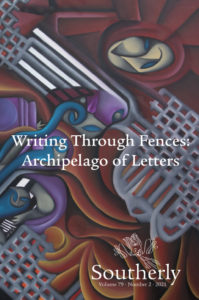 Writing Through Fences: Archipelago of Letters
Writing Through Fences: Archipelago of Letters
Southerly 79.2
Reviewed by MATTHEW da SILVA
It was while reading this issue of Southerly 7.2 Writing Through Fences— Archipelago of Letters that news emerged of the Australian government’s decision to allow some refugees in its care to resettle in New Zealand and for others to be released from a Melbourne hotel. It was as though the entire country gave a sigh of relief, attacks on the government coming thick and fast. Then the question of why it hadn’t happened sooner was overshadowed by Britain’s government announcing that it would establish an offshore processing regime with Rwanda as the linchpin. The problem of inequality had raised its head once more as another country tried to come to terms with its own attractiveness. It seems like the flow of migrants is unstoppable. Politicians’ job is to deal with it.
But they have help from the community, who are the ones, in the final result, who put them where they can make a difference. While lives – like those of the people featured in this issue of Southerly – had been damaged, the damage to Australia’s reputation remains unequal to the task of dimming its allure.
On social media, people have become hardened around talking points. Emotions are raw and feeling runs high with every indication that it will continue to do so. But is art the same thing as politics? I often wonder these days because the lines seem to blur and I worry that we’ll forget the reasons why we need art.
A Slate tweet of 21 March (7.04am) contained a headline and a comment: “200 Priceless Paintings That Belong to Russia Are Stranded in Paris. Will France Give Them Back? Art isn’t politics, but what if Putin wrote the preface to the exhibition’s catalog?”
Art isn’t politics, indeed.
Or Jay Rafferty’s tweet at 6.31am the same morning that went, “Bukowski affected my work a lot when I was younger, I think “The Laughing Heart” was one of my formative poems. But I, as many of us, have wised up. No hesitation in saying he was a dickhead with a few good poems and that’s probably the best compliment I can give him.”
Poor Charles, removed from his pedestal after all these years.
Can you still be a poet without being Virtue’s exemplar? Can you implement policies designed to stop drownings at sea and still stay friends with half the electorate? And what do we really want from art? Don’t we want it to answer questions for which conventional responses cannot serve? Questions that journalism, for example, cannot answer. What sorts of questions? Questions about that thing we easily label as the “soul” or those about the less easily described characteristics of a universe, the nature of which appears intent on releasing its last secrets slowly? Where, to posit the biggest one of all, did it all start?
Are poets to be limited, like 18th century’s Alexander Pope, to things pertaining to humanity, or do we risk considering other possibilities? Pope, for his part, didn’t accurately anticipate the liberation that sat on his doorstep but we seem to think we can see the future.
On the other hand I think about the possibility that Southerly’s appearance at this time (issue 79.2 came out last year) presumed a change of policy by Morrison and his colleagues. Are the publication and the refugee resettlement announcement somehow linked? When you read in this magazine accompanying material that illustrates the depth of the problem facing the government you come across evidence why their switch might be advised. A passion from such a deep reserve coming so close to the surface – printed on paper and distributed by mail to thousands of letterboxes – must give the authorities pause.
Discussions about Aboriginal sovereignty stand as a rebuke to politicians of most stripes. While the works featured in this issue of Southerly are not all of equal quality, this reviewer welcomes conversations, even those which are subversive. Hatred cannot be allowed to overcome collegiality, otherwise we’d all be invading others’ households without even knocking on the door, putting our feet up on the coffee table and asking rent for what isn’t ours. Like some son of the Vikings.
We have to respect diversity and its rules. Diversity is in fact a strength, and the ability to entertain multiple solutions to pressing problems is a hallmark of pluralistic democracy. The mainstream must always tolerate the margins.
Each of us has a voice. The voices you hear if you read this issue of Southerly are however normally silenced, and this is part of the beauty of this issue, curated by former detainees Hani Abdile, Behrouz Boochani, translator Omid Tofighian and refugee activist Janet Galbraith. Even the editorial voice is worth reading, though it’s (hopefully) not the reason why you’d buy the magazine. Editors must be wary of attempting to train reluctant voices into a chorus or of conscripting a contributor to approve a view they didn’t themselves hold. Melissa Lucashenko walks this balance valiantly.
I found pleasure in reading Hani Abdile’s ‘Oooh Old Friends’ though I couldn’t work out who the “friend” was, the poem skirting round the outside of names playfully. I think it was this aspect of the poem, which is regardless quite short, that drew me to it. Also short and elliptical is Mohamad Haghighi’s ‘Rainbow’ where the thing or person the poem is addressed to slips out of the reader’s view like a dream upon waking.
Sabaa’s ‘When?’ sits on more familiar territory (“When will I be free from detention? When will I see life outside the fence?”) but pinpoints the essential problem faced by legislators and advocates alike (“When will my country become a better place to live?”). There are occasional glimpses of the same ideas elsewhere, as in M.D. Imran’s ‘Lifelines’, which contains anecdotal evidence of the kinds of mistreatment causing refugees to go overseas to live. Imran is originally from Myanmar but now lives in Chicago, in the United States, following a period in exile in detention funded by the Australian taxpayer.
The depth of feeling that animates his journalism finds echoes elsewhere in the volume, for example in Sad Proof’s ‘I Love You’ where the country known as Australia (which the editors are careful to characterise as stolen land) is posited as finding its lover in the refugee (“I want to tell you I love you, Australia”) who will fight for its rights “and not give a chance to make [it] poor like my country”. Reading poems like this person’s made me think of the way that deaths at sea have played out in the media, especially on television, which brings me to considering the ways that politicians on both sides have sought to formulate refugee policy.
But there is little acknowledgement of these issues in the collection. Taking a leaf out of the playbook of more progressive elements of the commentariat, ‘Which Way to Go Back?’ asks Farhad Shah, and reading his poem you can understand a little more of the refugee experience. Less aggressive than some of the work in the book, ‘Which Way to Go Back?’ contains worlds and presents the comfortable reader – the sort of person who buys Southerly, who even bothers with poetry in the first place – with additional puzzles.
Its way of creating a dialogue made resonances with other poems, as though it were a familiar trope. It would be refreshing to think that the book was able to set up a dialogue, and perhaps this stage has already been reached.
The best poems in this book, like Abdul Samad Haidiri’s ‘Home – Where Else to Go?’ contain more than just a complaint, though always there is the bitterness of the outsider to flavour the work. In such poems you get to see something essential about the species, for having a home is an essential part of being human, in fact not only animals but even plants favour certain types of habitat over others, or even can only survive under certain conditions.
Adaptation is part of the refugee’s game plan however, as we see in Mabsud Masan’s ‘To Corrupt the System Is to Have Compassion’ which uses elements of Pidgin in a creole designed to give a taste of life on Manus Island. It’s a bit rebarbative but entirely comprehensible, our discomfort – it would be strange to eliminate all traces of the voyage – enhancing the experience of reading the journalism. A short piece by notable advocate Behrouz Boochani demonstrates this writer’s ability to pack a punch into a smaller space.
Farhad Bandesh (with Melita Luck) uses poetic language that draws heavily on the natural world to create a picture of the refugee experience that adds lustre to the whole. It’s as though because the desire for the goal is so complete there are few ways to communicate the depth of feeling that constitutes reality for someone in his position. Absolute joy, complete abandon. Hatred, fear. Like in a Hollywood gangster movie, or some rich concoction where the fate of civilisation rests in the hands on a renegade hero, and the only way to secure it is through extreme violence, we’re able with these poems to get down to essentials. But the experience is no less rich for the simplification that takes place. As in Shiharan Ganeshan’s gentle story (short fiction rare in the book) titled ‘Flute’, which is a kind of fable about class, art, meaning, and fate that is laced, as in an old Arabian-night story, with magic and with its own brand of suppressed yearning.
I wish that every person who wanted to come to this country had easy passage, and in fact on a blog years ago suggested opening up a refugee processing centre in Jakarta. Unfortunately I probably lack requisite experience and insight and can only write meagre reviews of wonderful books of poetry and prose – with a few delightful artworks added for good measure – but if I can encourage one person to read this issue of Southerly I’ll be happy.
MATTHEW da SILVA was born in Brighton, Victoria, and grew up in Sydney. He has Bachelor of Arts and Master of Media Practice degrees from the University of Sydney and lived for just under a decade in Tokyo. He has two adult children and lives in Sydney.
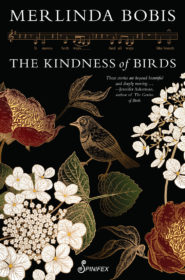 The Pigeons Are Taking Over: The Kindness of Birds
The Pigeons Are Taking Over: The Kindness of Birds 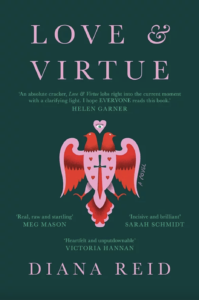 Love & Virtue
Love & Virtue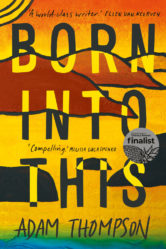 Born Into This
Born Into This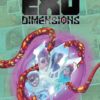 Exo-Dimensions, Mixed Feelings, Storm Warning
Exo-Dimensions, Mixed Feelings, Storm Warning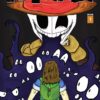 by Seraphina Newberry & Justin Randall, Declan Miller, Lauren Boyle & Alyssa Mason
by Seraphina Newberry & Justin Randall, Declan Miller, Lauren Boyle & Alyssa Mason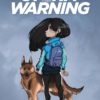
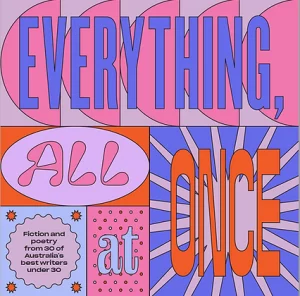 Everything, all at Once
Everything, all at Once Eurydice Speaks
Eurydice Speaks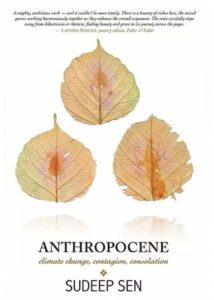 Anthropocene
Anthropocene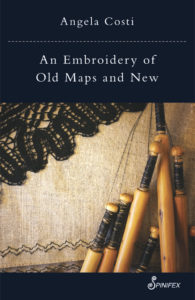 An Embroidery of Old Maps and New
An Embroidery of Old Maps and New